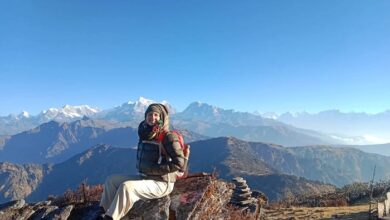Trekking the Everest: From Lukla to Namche, through the Three Passes, and onto Everest Base Camp

Venturing on a trek in the Everest region is a dream for many. The journey from Lukla to the Everest Base Camp (EBC), incorporating the challenging Three Pass Trek, offers an exhilarating experience of natural beauty and cultural immersion. Here’s an in-depth look at this trail, showcasing its beauty, challenges, and the best times to undertake this journey.
Beginning at Lukla: The Gateway to Everest
Trekking in the Everest region typically starts from Lukla, a small town known for its hair-raising Tenzing-Hillary Airport. Despite the adrenaline-pumping landing, the breathtaking scenery of Lukla sets the tone for the days ahead.
Namche Bazaar: The Sherpa Heartland
A two-day trek from Lukla through dense forests and suspension bridges over the Dudh Kosi River leads you to Namche Bazaar. Known as the ‘Sherpa capital’, it’s a bustling hub with colourful markets, teahouses, and spectacular views of the Himalayan giants, including Everest and Ama Dablam. It’s also a crucial acclimatization point before heading to higher altitudes.
Three Passes Trek: An Adventurous Divergence
While many opt for the direct route to EBC, thrill-seekers venture onto the Three Passes Trek. This challenging circuit covers the Kongma La, Cho La, and Renjo La passes, offering trekkers unmatched panoramic views, isolated trails, and a deeper immersion into the Khumbu region.
- Kongma La: The first pass on the circuit, Kongma La, connects the Chhukung and Lobuche areas and offers awe-inspiring views of Makalu, Ama Dablam, and the Khumbu Glacier.
- Cho La: Leading from Dzongla to the Gokyo Valley, Cho La is the most challenging due to its icy traverse but rewards trekkers with magnificent views of Everest, Lhotse, Nuptse, and Cholatse.
- Renjo La: Connecting the Gokyo Valley to Thame, Renjo La offers a stunning view of the Gokyo Lakes and is the culmination of the three passes before heading towards EBC.
Everest Base Camp: The Pinnacle of the Journey
After the Three Passes, the journey continues through Gorakshep, a launch point to both EBC and the stunning Kala Patthar viewpoint. At the base camp, trekkers stand face to face with the Khumbu Icefall while the formidable Everest towers in the backdrop, a sight that evokes emotions, making every step of the journey worthwhile.
When to Embark on This Adventure?
The best times to undertake this journey are during the pre-monsoon (March to May) and post-monsoon (late September to November) periods.
Spring (March to May): This is the most popular time for trekking in the Everest region. The temperatures are relatively warmer, and the trails are adorned with vibrant rhododendron blooms. However, it’s also the busiest season, so be prepared for crowded trails.
Autumn (Late September to November): Post the monsoons, the skies clear up, offering crisp mountain views. The temperatures start dropping, especially in late November, but the trails are less crowded compared to the spring season.
Avoiding the Monsoons and Winters: June to early September witnesses heavy monsoons, making trails slippery and prone to landslides. Winters (December to February) are incredibly cold, especially at higher altitudes, and many teahouses may be closed. However, for those seeking solitude, winter presents a serene, crowd-free trekking experience.
In Conclusion
Trekking from Lukla through Namche, conquering the Three Passes, and reaching the Everest Base Camp is an adventure of a lifetime. Beyond the natural grandeur, it’s a journey into the heart of Sherpa culture, its traditions, and its legendary mountaineering spirit. Remember, adequate preparation, respecting the environment, and acclimatizing correctly is key to making this journey memorable. So, strap on your trekking boots and answer the call of the mountains!




